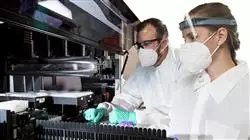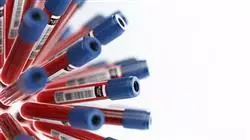University certificate
The world's largest faculty of medicine”
Introduction to the Program
This program will allow you to integrate the latest advances in hematology into your daily work, delving into issues such as von Willebrand disease or Waldenström's macroglobulinemia"

In recent years, hematology has undergone major transformations that have led to the incorporation of numerous new procedures, diagnostic techniques and scientific discoveries. As such, the discipline has recently undergone remarkable changes, driven by the continuous advances made by researchers and specialists. For this reason, physicians whose careers are related to this field need to get up to speed immediately, a goal that they will be able to achieve thanks to this program.
This Advanced master’s degree in Clinical Hematology has brought together all the innovations in this area, integrating in a single degree not only aspects such as the latest developments in the physiology of hemostasis, but also other fields such as transfusion medicine. Accordingly, this program is the most complete and up-to-date on the market, and will delve into other relevant issues such as plasma cell dyscrasias, oncohematological diseases such as leukemias and lymphomas or the latest advances in transfusion in pediatric patients.
Thanks to this degree, the specialist will be able to update their knowledge through an online teaching system that will make it very easy to study, since it will not subject them to rigid schedules or uncomfortable commutes. Additionally, students will be supported by a highly prestigious teaching staff in the field of hematology, who will provide them with all the latest developments in the discipline using the best teaching resources, presented in various multimedia formats.
You will be able to learn the most recent developments in plasma cell dyscrasias through a 100% online teaching methodology"
This Advanced master’s degree in Clinical Hematology contains the most complete and up-to-date scientific program on the market. The most important features include:
- Practical cases presented by experts in medicine
- The graphic, schematic, and eminently practical contents with which they are created, provide scientific and practical information on the disciplines that are essential for professional practice
- Practical exercises where self-assessment can be used to improve learning
- Special emphasis on innovative methodologies in Clinical Hematology
- Theoretical lessons, questions to the expert, debate forums on controversial topics, and individual reflection assignments
- Content that is accessible from any fixed or portable device with an Internet connection
No rigid schedules or uncomfortable commutes. Update your knowledge in hematology from your home or office, at your own pace, whenever and however you want"
Its teaching staff includes professionals from the field of hematology, who contribute to this program the experience of their work, as well as renowned specialists from leading societies and prestigious universities.
The multimedia content, developed with the latest educational technology, will provide the professional with situated and contextual learning, i.e., a simulated environment that will provide an immersive learning experience designed to train for real-life situations.
This program is designed around Problem-Based Learning, whereby the student must try to solve the different professional practice situations that arise during the academic year. For this purpose, the professional will be assisted by an innovative interactive video system created by renowned and experienced experts.
Throughout the program, you will receive guidance from a highly regarded faculty in the field of hematology"

You will have state-of-the-art multimedia resources at your disposal: case studies, procedural videos, master classes, interactive summaries"
Why study at TECH?
TECH is the world’s largest online university. With an impressive catalog of more than 14,000 university programs available in 11 languages, it is positioned as a leader in employability, with a 99% job placement rate. In addition, it relies on an enormous faculty of more than 6,000 professors of the highest international renown.

Study at the world's largest online university and guarantee your professional success. The future starts at TECH”
The world’s best online university according to FORBES
The prestigious Forbes magazine, specialized in business and finance, has highlighted TECH as “the world's best online university” This is what they have recently stated in an article in their digital edition in which they echo the success story of this institution, “thanks to the academic offer it provides, the selection of its teaching staff, and an innovative learning method aimed at educating the professionals of the future”
A revolutionary study method, a cutting-edge faculty and a practical focus: the key to TECH's success.
The most complete study plans on the university scene
TECH offers the most complete study plans on the university scene, with syllabuses that cover fundamental concepts and, at the same time, the main scientific advances in their specific scientific areas. In addition, these programs are continuously being updated to guarantee students the academic vanguard and the most in-demand professional skills. In this way, the university's qualifications provide its graduates with a significant advantage to propel their careers to success.
TECH offers the most comprehensive and intensive study plans on the current university scene.
A world-class teaching staff
TECH's teaching staff is made up of more than 6,000 professors with the highest international recognition. Professors, researchers and top executives of multinational companies, including Isaiah Covington, performance coach of the Boston Celtics; Magda Romanska, principal investigator at Harvard MetaLAB; Ignacio Wistumba, chairman of the department of translational molecular pathology at MD Anderson Cancer Center; and D.W. Pine, creative director of TIME magazine, among others.
Internationally renowned experts, specialized in different branches of Health, Technology, Communication and Business, form part of the TECH faculty.
A unique learning method
TECH is the first university to use Relearning in all its programs. It is the best online learning methodology, accredited with international teaching quality certifications, provided by prestigious educational agencies. In addition, this disruptive educational model is complemented with the “Case Method”, thereby setting up a unique online teaching strategy. Innovative teaching resources are also implemented, including detailed videos, infographics and interactive summaries.
TECH combines Relearning and the Case Method in all its university programs to guarantee excellent theoretical and practical learning, studying whenever and wherever you want.
The world's largest online university
TECH is the world’s largest online university. We are the largest educational institution, with the best and widest online educational catalog, one hundred percent online and covering the vast majority of areas of knowledge. We offer a large selection of our own degrees and accredited online undergraduate and postgraduate degrees. In total, more than 14,000 university degrees, in eleven different languages, make us the largest educational largest in the world.
TECH has the world's most extensive catalog of academic and official programs, available in more than 11 languages.
Google Premier Partner
The American technology giant has awarded TECH the Google Google Premier Partner badge. This award, which is only available to 3% of the world's companies, highlights the efficient, flexible and tailored experience that this university provides to students. The recognition as a Google Premier Partner not only accredits the maximum rigor, performance and investment in TECH's digital infrastructures, but also places this university as one of the world's leading technology companies.
Google has positioned TECH in the top 3% of the world's most important technology companies by awarding it its Google Premier Partner badge.
The official online university of the NBA
TECH is the official online university of the NBA. Thanks to our agreement with the biggest league in basketball, we offer our students exclusive university programs, as well as a wide variety of educational resources focused on the business of the league and other areas of the sports industry. Each program is made up of a uniquely designed syllabus and features exceptional guest hosts: professionals with a distinguished sports background who will offer their expertise on the most relevant topics.
TECH has been selected by the NBA, the world's top basketball league, as its official online university.
The top-rated university by its students
Students have positioned TECH as the world's top-rated university on the main review websites, with a highest rating of 4.9 out of 5, obtained from more than 1,000 reviews. These results consolidate TECH as the benchmark university institution at an international level, reflecting the excellence and positive impact of its educational model.” reflecting the excellence and positive impact of its educational model.”
TECH is the world’s top-rated university by its students.
Leaders in employability
TECH has managed to become the leading university in employability. 99% of its students obtain jobs in the academic field they have studied, within one year of completing any of the university's programs. A similar number achieve immediate career enhancement. All this thanks to a study methodology that bases its effectiveness on the acquisition of practical skills, which are absolutely necessary for professional development.
99% of TECH graduates find a job within a year of completing their studies.
Advanced Master's Degree in Clinical Hematology
.
Hematology is one of the most important resources for medicine, among other things, because it allows the diagnosis of a wide spectrum of pathologies; from disorders such as anemia, thrombosis and hemophilia, to oncological diseases. In recent years, this specialty has undergone significant advances in its various areas of study and in the therapeutic methods available for intervention and hospital care of patients. Taking into account that this is one of the most complex health disciplines today, which not only requires solid conceptual foundations, but also the permanent updating of the knowledge and skills of specialists, at TECH Global University we designed this Advanced Master's Degree in Clinical Hematology. Thus, through this program, you will be able to integrate the latest discoveries, procedures and hematological techniques and excel in the application of these to your daily clinical practice.
Get your degree at the largest medical school in the world
.
From a completely online methodology, you will have the opportunity to acquire the most advanced knowledge in the field of clinical hematology. Thanks to these, you will delve into aspects such as marrow and bleeding disorders, the physiology of hemostasis, immunohematology and oncohematological diseases, among other issues. You will also review the blood donation process, as well as strategies for saving and processing blood components. At the largest medical school in the world, you will have the tools, strategies and resources necessary to enhance your professional growth in this field, along with a team of highly qualified professionals to guide you and develop your skills to the maximum. Our Advanced Master's Degree in Clinical Hematology is the next step in making your professional goals a reality.







